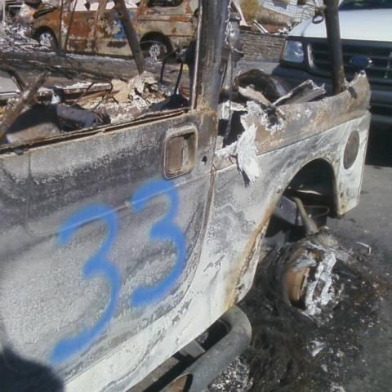 5:08 PM: The National Transportation Safety Board today issued several urgent safety recommendations to PG&E and gas pipeline regulators as part of its investigation into the deadly Sept. 9 explosion in San Bruno.
5:08 PM: The National Transportation Safety Board today issued several urgent safety recommendations to PG&E and gas pipeline regulators as part of its investigation into the deadly Sept. 9 explosion in San Bruno.
The NTSB has found that the type of gas transmission pipeline PG&E installed below the Crestmoor Canyon neighborhood in 1956 differed from PG&E’s own records, calling into question the accuracy of the “maximum allowable operating pressure” determined for Line 132.
The acceptable operation pressure of Line 132 has come into question after it ruptured and exploded four months ago, killing eight people and destroying 35 homes.
Rep. Jackie Speier, D-San Mateo, applauded the NTSB findings at a news conference this afternoon and said that the agency’s investigation shows that there is something fundamentally wrong with PG&E’s recording of its own infrastructure.
“PG&E, in my book, has lost a great deal of credibility,” Speier said.
“It’s critical that operators be able to prove what is under the ground.”
The NTSB has subsequently issued a series of seven safety recommendations – six of them urgent – to PG&E, the California Public Utilities Commission, and other gas companies it regulates regarding testing of transmission pipelines.
The agency has recommended that PG&E provide an absolutely complete and accurate inventory of its pipelines, especially those that run through highly populated areas.
Wherever records are incomplete or inconsistent, PG&E should complete intensive hydrostatic testing to determine their maximum allowable gas pressure, according to the NTSB.
“It is possible that there are other discrepancies between installed pipe and as-built drawings in PG&E’s gas transmission system,” NTSB Chairwoman Deborah Hersman said in a letter to the utilities commission.
PG&E vice president of gas engineering and operations Kirk Johnson said in a statement that the utility company is carefully reviewing the NTSB recommendations.
“We have been undertaking an intensive review of our pipeline records, scrutinizing and verifying thousands of documents to confirm the quality of our data,” Johnson said.
2:51 PM: The National Transportation Safety Board today issued several urgent safety recommendations to PG&E and gas pipeline regulators as part of its investigation into the deadly Sept. 9 explosion in San Bruno.
The NTSB has found that the type of gas transmission pipeline PG&E installed below the Crestmoor Canyon neighborhood in 1956 differed from PG&E’s own records, calling into question the accuracy of the “maximum allowable operating pressure” determined for Line 132.
The acceptable operation pressure of Line 132 has come into question after it ruptured and exploded four months ago, killing eight people and destroying 35 homes.
The NTSB has subsequently issued a series of seven safety recommendations – six of them urgent – to the PG&E, the California Public Utilities Commission and other gas companies it regulates regarding testing of transmission pipelines.
“It is possible that there are other discrepancies between installed pipe and as-built drawings in PG&E’s gas transmission system,” NTSB Chairwoman Deborah Hersman said in a letter to the utilities commission.
Chris Cooney, Bay City News
Want more news, sent to your inbox every day? Then how about subscribing to our email newsletter? Here’s why we think you should. Come on, give it a try.









